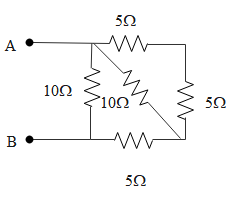
The effective resistance between the terminals A and B is equal to:

(A) 25 ohms
(B) 15 ohms
(C) 10 ohms
(D) 5 ohms
Answer
218.7k+ views
Hint: To answer this question we need to know that series resistance is given by ${R_S} = {R_1} + {R_2} + {R_3}....... + {R_N}$, and parallel connection of resistances is given by $1/{R_p} = 1/{R_1} + 1/{R_2} + 1/{R_3}....... + 1/{R_N}$. Using this formula, we have to find out the equivalent resistance between the terminals A and B.
Complete step by step answer:
The circuit can be reduced, step by step, to a single equivalent resistance.
The 5 ohm and the 5 ohm that are connected to the terminal A are in series, and so they can be replaced by an equivalent resistor, which is denoted by ${R_{S1}}$. The value of ${R_{S1}}$ is 10 ohm, by using the equation given below:
${R_S}$= 5 + 5 = 10 ohms.
This is the resistance ${R_{S1}}$ of 10 ohms is now connected parallel to another 10 ohm resistance. This connection can be reduced to a single equivalent resistance ${R_p}$. They are connected in series and the equivalent resistance ${R_p}$is given as below:
$\dfrac{1}{{{R_p}}} = \dfrac{1}{{10}} + \dfrac{1}{{10}} = 5ohms$
Now the resistance ${R_p}$and 5 ohms are connected in series and the equivalent resistance ${R_{S2}}$ is given as ${R_{S2}}$= 5+5= 10 ohms.
The resistances ${R_{S1}}$and the remaining 10 ohm resistance are connected parallel and hence, the total resistance in the circuit is given as follows:
$\dfrac{1}{R} = \dfrac{1}{{10}} + \dfrac{1}{{{R_{S2}}}} = \dfrac{1}{{10}} + \dfrac{1}{{10}} = 5ohms$
Hence the resistance across the terminals A and B is 5 ohms. So the correct answer is option D.
Note: We should know that a parallel circuit will have two more than two paths for the current to pass through it. The sum of the currents passing through each of the paths will be equal to the total current that is flowing from the source. On the other hand, the total resistance in a series circuit will be equal to the sum of the individual resistances. Similarly, the voltage applied in the series circuit will be similar to the addition of all the individual voltage drops.
Complete step by step answer:
The circuit can be reduced, step by step, to a single equivalent resistance.
The 5 ohm and the 5 ohm that are connected to the terminal A are in series, and so they can be replaced by an equivalent resistor, which is denoted by ${R_{S1}}$. The value of ${R_{S1}}$ is 10 ohm, by using the equation given below:
${R_S}$= 5 + 5 = 10 ohms.
This is the resistance ${R_{S1}}$ of 10 ohms is now connected parallel to another 10 ohm resistance. This connection can be reduced to a single equivalent resistance ${R_p}$. They are connected in series and the equivalent resistance ${R_p}$is given as below:
$\dfrac{1}{{{R_p}}} = \dfrac{1}{{10}} + \dfrac{1}{{10}} = 5ohms$
Now the resistance ${R_p}$and 5 ohms are connected in series and the equivalent resistance ${R_{S2}}$ is given as ${R_{S2}}$= 5+5= 10 ohms.
The resistances ${R_{S1}}$and the remaining 10 ohm resistance are connected parallel and hence, the total resistance in the circuit is given as follows:
$\dfrac{1}{R} = \dfrac{1}{{10}} + \dfrac{1}{{{R_{S2}}}} = \dfrac{1}{{10}} + \dfrac{1}{{10}} = 5ohms$
Hence the resistance across the terminals A and B is 5 ohms. So the correct answer is option D.
Note: We should know that a parallel circuit will have two more than two paths for the current to pass through it. The sum of the currents passing through each of the paths will be equal to the total current that is flowing from the source. On the other hand, the total resistance in a series circuit will be equal to the sum of the individual resistances. Similarly, the voltage applied in the series circuit will be similar to the addition of all the individual voltage drops.
Recently Updated Pages
A square frame of side 10 cm and a long straight wire class 12 physics JEE_Main

The work done in slowly moving an electron of charge class 12 physics JEE_Main

Two identical charged spheres suspended from a common class 12 physics JEE_Main

According to Bohrs theory the timeaveraged magnetic class 12 physics JEE_Main

ill in the blanks Pure tungsten has A Low resistivity class 12 physics JEE_Main

The value of the resistor RS needed in the DC voltage class 12 physics JEE_Main

Trending doubts
JEE Main 2026: Application Form Open, Exam Dates, Syllabus, Eligibility & Question Papers

Understanding Uniform Acceleration in Physics

Derivation of Equation of Trajectory Explained for Students

Hybridisation in Chemistry – Concept, Types & Applications

Understanding the Angle of Deviation in a Prism

Understanding Collisions: Types and Examples for Students

Other Pages
JEE Advanced Marks vs Ranks 2025: Understanding Category-wise Qualifying Marks and Previous Year Cut-offs

Understanding Atomic Structure for Beginners

How to Convert a Galvanometer into an Ammeter or Voltmeter

Understanding Centrifugal Force in Physics

JEE Main Marking Scheme 2026- Paper-Wise Marks Distribution and Negative Marking Details

Degree of Dissociation: Meaning, Formula, Calculation & Uses




